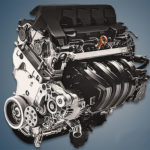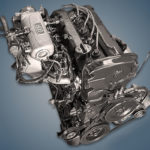The 1.5-liter 12-valve Hyundai G4EK engine was produced by the company from 1991 to 2000 and was installed on such popular models of the Korean concern as Accent, Lantra and Scoupe. In addition to the atmospheric modification of this engine, there was a rare turbocharged version.
In 1991, the Alpha family of gasoline engines debuted on the Hyundai Scoupe model and its first representative was a 1.5-liter 12-valve unit under the G4EK index. This motor replaced the Mitsubishi 4G15 and for some time they were produced in parallel. The Japanese engine is easy to distinguish by its aluminum cover and does not have hydraulic lifters.
The design of the Korean motor is typical for its time: distributed fuel injection, a cast-iron cylinder block and an aluminum 12-valve SOHC head with hydraulic lifters, a simple timing belt drive and a very up-to-date dual coil ignition system. In addition to the atmospheric modification, a supercharged version with a Garrett TB1501 turbine was also produced.
The Alpha series includes: G4EA, G4EH, G4EE, G4EB, G4EC, G4ER, G4EK, G4ED.
The engine was installed on:
- Hyundai Accent 1 (X3) in 1994 – 1999;
- Hyundai Lantra 2 (RD) in 1995 – 2000;
- Hyundai Scoupe 1 (X2) in 1991 – 1996.
Specifications
| Production years | 1991-2000 |
| Displacement, cc | 1495 |
| Fuel system | distributed injection |
| Power output, hp | 88 – 91 (atmospheric G4EK) 115 (turbocharged G4EK-TC) |
| Torque output, Nm | 126 – 134 (atmospheric G4EK) 170 (turbocharged G4EK-TC) |
| Cylinder block | cast iron R4 |
| Block head | aluminum 12v |
| Cylinder bore, mm | 75.5 |
| Piston stroke, mm | 83.5 |
| Compression ratio | 10.0 (atmospheric G4EK) 7.5 (turbocharged G4EK-TC) |
| Features | SOHC |
| Hydraulic lifters | yes |
| Timing drive | belt |
| Turbocharging | no (atmospheric G4EK) Garrett TB1501 (turbocharged G4EK-TC) |
| Recommended engine oil | 5W-40, 10W-40 |
| Engine oil capacity, liter | 3.8 |
| Fuel type | petrol |
| Euro standards | EURO 2 |
| Fuel consumption, L/100 km (for Hyundai Lantra 1997) — city — highway — combined |
10.2 5.9 7.1 |
| Engine lifespan, km | ~300 000 |
| Weight, kg | 101.3 – 107.9 |
Disadvantages of the Hyundai G4EK engine
- The first years of production had many problems with build quality and some components, but then everything was fixed and now most of the complaints are related to floating engine speeds due to a dirty throttle and idle speed controller, as well as engine tripping due to a cracked coil.
- Another weak point of this motor is the low resource of hydraulic lifters. Versions of the reasons differ: some blame the workmanship, others blame the bad oil, and still others the drop in lubrication pressure in the system due to the imminent wear of the oil pump plunger.
- Quite a few engines of the Alpha family failed after the timing belt broke, since the replacement schedule every 60,000 km is slightly optimistic. It often breaks early. Together with the belt, it is desirable to change the water pump, its resource is also not very large.
- The oil consumption of such power units appears on runs from 100 to 200 thousand km, this greatly depends on the quality of service and on the mode of operation of your car. Usually, you can get rid of the oil burner by replacing the valve stem seals or rings.
- Weaknesses also include unreliable attachments, weak engine mounts, regular lubricant or antifreeze leaks, and ECU glitches due to burnout of the muffler corrugation. If the engine does not start, then look at the emergency fuel cut-off mechanism.







I
Want to see the proper cooling system exploded view of G4EK 1.5 lit motor in 1997 Hyundai X3